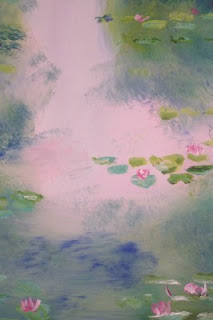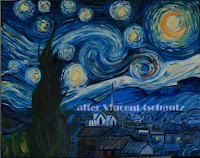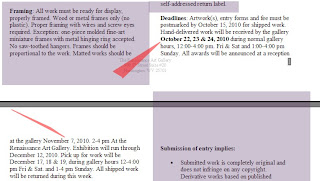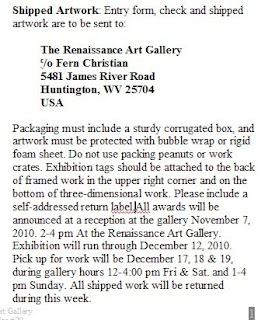In one sense, all artwork is derivative work. Everything we do is based on what came before us. None of us invented artwork. While I paint in oils, I did not invent them. I don’t grind my own colors nor do I weave my own canvas. Nor am I the first artist to paint on canvas. And although I many look old enough, I assure you I did not invent the pencil.
My work is based on what came before me. I looked at artwork. I saw what was there and was inspired by it. My mom was always buying prints of great artwork. These were all over my house growing up. Later I did take art and craft classes. I studied anatomy, and along with drawing from life, I saw how other artists before me and around me solved the problems of rendering the image of the live figure onto paper.
My work is based on what came before me. I looked at artwork. I saw what was there and was inspired by it. My mom was always buying prints of great artwork. These were all over my house growing up. Later I did take art and craft classes. I studied anatomy, and along with drawing from life, I saw how other artists before me and around me solved the problems of rendering the image of the live figure onto paper.
To Derive or Not to Derive
Being inspired by classic artwork is normal. Often I will encourage new students to spend time looking at and even coping some of the great masters. It is an excellent way to learn to paint and draw. This used to be quite common. Touring art museums, you would see students painting or sketching from the paintings on the wall. Since 9/11, most places don’t all ow this anymore. Nor do most they allow photography, but that is another subject.
ow this anymore. Nor do most they allow photography, but that is another subject.
Are these derivative work? Well, of course they are. As you gain more and more experience, your own work will diverge more and more from those of the masters. One of the first paintings I ever did was based on a Normal Rockwell poster. I was new, and did not know anything about copyright, and I would never display this, but I learned a lot. But I no longer try to paint this way. I no longer feel the urge to copy. And as you progress, you should get away from copying others and do work based on your own esthetics's.
One artist I know, selects a new artist each year to study, to work from their work, and learn their processes. What she learned can become part of her own artistic psyche. This work is done only for self education, and does not become part of her portfolio or ever make it to display. It is a way of stretching her artistic muscles.
I have done this myself. I love Monet, especially his earlier works. After seeing a traveling show of Monet canvases, I and several of my students did our own version of one of his water lily paintings. Can you tell these are based on Monet’s paintings? Well. It is hard to do any water lily paintings that does not harkens back to Monet. Water lilies are so closely co nnected to Monet that any water lily painting will be compared to his. I have done other water lily paintings that are not based on his water lilies but on my own photographs of water lilies taken at Longwood Gardens. But it is enviable that it will be compared to Monet. The first may or may not be recognized as a derivative work. Frankly, I have been painting too long to copy well. And I never was that good at copying others work. The other is not. It is clearly my own work.
nnected to Monet that any water lily painting will be compared to his. I have done other water lily paintings that are not based on his water lilies but on my own photographs of water lilies taken at Longwood Gardens. But it is enviable that it will be compared to Monet. The first may or may not be recognized as a derivative work. Frankly, I have been painting too long to copy well. And I never was that good at copying others work. The other is not. It is clearly my own work.
Being inspired by classic artwork is normal. Often I will encourage new students to spend time looking at and even coping some of the great masters. It is an excellent way to learn to paint and draw. This used to be quite common. Touring art museums, you would see students painting or sketching from the paintings on the wall. Since 9/11, most places don’t all
 ow this anymore. Nor do most they allow photography, but that is another subject.
ow this anymore. Nor do most they allow photography, but that is another subject.Are these derivative work? Well, of course they are. As you gain more and more experience, your own work will diverge more and more from those of the masters. One of the first paintings I ever did was based on a Normal Rockwell poster. I was new, and did not know anything about copyright, and I would never display this, but I learned a lot. But I no longer try to paint this way. I no longer feel the urge to copy. And as you progress, you should get away from copying others and do work based on your own esthetics's.
One artist I know, selects a new artist each year to study, to work from their work, and learn their processes. What she learned can become part of her own artistic psyche. This work is done only for self education, and does not become part of her portfolio or ever make it to display. It is a way of stretching her artistic muscles.
I have done this myself. I love Monet, especially his earlier works. After seeing a traveling show of Monet canvases, I and several of my students did our own version of one of his water lily paintings. Can you tell these are based on Monet’s paintings? Well. It is hard to do any water lily paintings that does not harkens back to Monet. Water lilies are so closely co
 nnected to Monet that any water lily painting will be compared to his. I have done other water lily paintings that are not based on his water lilies but on my own photographs of water lilies taken at Longwood Gardens. But it is enviable that it will be compared to Monet. The first may or may not be recognized as a derivative work. Frankly, I have been painting too long to copy well. And I never was that good at copying others work. The other is not. It is clearly my own work.
nnected to Monet that any water lily painting will be compared to his. I have done other water lily paintings that are not based on his water lilies but on my own photographs of water lilies taken at Longwood Gardens. But it is enviable that it will be compared to Monet. The first may or may not be recognized as a derivative work. Frankly, I have been painting too long to copy well. And I never was that good at copying others work. The other is not. It is clearly my own work.Same with “Starry Night”. Who does not recognize this work by Vincent? A year ago, we at The Renaissance Art Gallery did a group project to do our own rendition of that famous painting. It was a great learning experience, and we make clear it was based on this old painting. Which is not uncommon, and anything in the public domain can be copied to various extents. One reason the old masters turn up in ads so much. But these are all derivative works, and although not illegal still not eligible for competition.

Artwork to the right, both inspired by Monet's many water lily paintings. One is derivative, the other inspired by but based on my own visits to botancial gardens with lily ponds. And of course, we all recognize "Starry Night"





